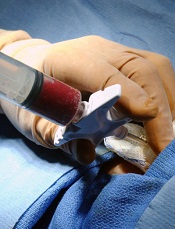
Photo by Chad McNeeley
ORLANDO, FL—In a large, registry-based study, transplants from human leukocyte antigen (HLA)-identical sibling donors proved successful in more than 90% of children and adults with severe sickle cell disease (SCD).
However, younger patients and those who received bone marrow (BM) or cord blood (CB) transplants fared the best.
Patient age and stem cell source were both independently associated with event-free and overall survival.
These results suggest SCD patients should be referred for transplant early but should not receive peripheral blood stem cell (PBSC) transplants, said Barbara Cappelli, MD, of the Eurocord International Registry in Paris, France.
Dr Cappelli presented the results of this study at the 2015 ASH Annual Meeting (abstract 541*).
The study included 1000 SCD patients who received HLA-identical sibling transplants from 1986 through 2013. The transplants took place at 88 centers in 23 countries and were reported to the Eurocord-Monacord/European Group for Blood and Marrow Transplantation and the Center for International Blood and Marrow Transplant Research.
The patients’ median age was 9 (range, 1-54), and most (85%) were younger than 16. Most patients (94%) were homozygotes for hemoglobin S. Most had received red blood cell transfusions (94%), and a little more than half had received hydroxyurea (56%).
About half of HSCTs (53%) were performed after 2007, 29% from 2000 to 2006, 16% from 1991 to 1999, and 2% before 1999.
The most common indication for HSCT was recurrent vaso-occlusive crisis (77%), followed by stroke or central nervous system event (48%), and recurrent chest syndrome (32%), among other indications.
Most patients received BM transplants (84%), although a minority received CB (9%) or PBSC (7%) transplants.
A majority of patients received myeloablative conditioning regimens (n=873, 87%), largely based on the combination of busulfan and cyclophosphamide (n=719). Among the patients who received reduced-intensity conditioning (n=127, 13%), fludarabine with cyclophosphamide was the predominant regimen (n=48).
Most regimens included in vivo T-cell depletion (70%) with anti-thymocyte globulin (n=630) or alemtuzumab (n=76). The most common regimen for graft-vs-host disease (GVHD) prophylaxis was cyclosporine plus methotrexate (56%).
Results
The median follow-up was 45 months (range, 1-325).
At 60 days, the cumulative incidence of neutrophil engraftment was 98%, and the median time to neutrophil engraftment was 19 days. The cumulative incidence of platelet engraftment was 96%, and the median time to platelet engraftment was 25 days.
Acute GVHD occurred in 14.4% of patients, and chronic GVHD occurred 13.3%.
Multivariate analysis showed that the risk of acute GVHD was significantly higher in older patients, but none of the variables the researchers tested (T-cell depletion, conditioning regimen, etc.) were associated with chronic GVHD.
Younger age at HSCT and receiving a BM or CB transplant were independently associated with better event-free survival and overall survival. Undergoing HSCT after the year 2000 was associated with better overall survival.
The 3-year event-free survival was 90% overall, 90% for patients who received BM transplants, 78% for those who received PBSCs, and 97% for those who received CB transplants.
The 3-year overall survival was 94% overall, 94% for patients who received BM transplants, 80% for those who received PBSCs, and 99% for those who received CB transplants.
Seventy-one patients (7%) had autologous reconstitution (45 with late graft failure), 31 (3%) underwent a second HSCT, and 67 (7%) died—6% in the BM group, 21% in the PBSC group, and 1% in the CB group.
Death was related to transplant in 59 cases—14 due to infection, 12 due to toxicity, 9 due to GVHD, and 24 were of an unknown (but presumably HSCT-related) cause.
Three patients died from disease recurrence or persistence, 2 died from secondary malignancies, and 3 had unknown causes of death.
“This study shows excellent 3-year overall and event-free survival, with limited toxicity, despite the use of myeloablative conditioning regimens,” Dr Cappelli noted. “This should increase the early referral to transplant for patients with severe sickle cell disease, as age is an independent predictor for event-free survival and overall survival.”
She added that PBSC transplants “are not recommended,” as they were associated with higher mortality. And novel strategies are needed for lowing rates of graft failure and GVHD in SCD patients.

*Data in the abstract differ from the presentation.

